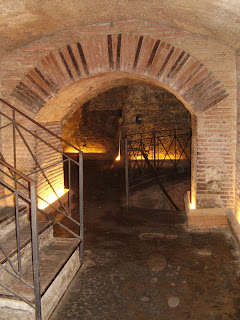On Sunday afternoon, my lovely friend Francesca invited me to join a scout group on a tour of a Roman/Greek theatre. It was originally an amphitheatre seated an audience of 5000. The theatre was partly demolished and built over in order for new housing to be established. It was customary that old buildings be destroyed, which is in direct contrast to our current thinking that old buildings, structures and ruins are to be restored and preserved.
The famous emperor Nero enjoyed performing in this amphitheatre as an actor in religious dramas. Our guide informed that he paid the audience to attend. His artistic endeavours were considered scandalous by the aristocracy and his army.
Nero was said to be responsible for the burning of two thirds of Rome in 64 AD, although modern scholars continue to debate this. It was true however that in order to gain power he murdered many of his political enemies and ordered the execution of his mother and wife. In 68 AD, the Roman senate declared him an enemy of the state and he committed suicide.
We entered the building, into what was a private apartment. A bed was pushed back into the kitchen and this revealed a door in the floor that opened up. A staircase led down into the amphitheatre underneath the house. Only part of the original amphitheatre is accessible as much of it has been filled in or is blocked off by the foundations of adjoining buildings.
Nevertheless, it was fascinating to stand where Neapolitans stood some 2000 years ago, enduring what was surely yet another horrendous performance by the fifth emperor of Rome.
Even more fascinating was listening to the eager boy scouts ask questions about the theatre and its history. Our guide eventually told one boy not to believe everything that he sees on television and the movies. It seemed that most of his knowledge was gleaned from the screen, making him a historical expert, in accordance with the ways of all ten-year-old boys.
I’m sure he would have had something to share with Nero too had the opportunity arisen.
The famous emperor Nero enjoyed performing in this amphitheatre as an actor in religious dramas. Our guide informed that he paid the audience to attend. His artistic endeavours were considered scandalous by the aristocracy and his army.
Nero was said to be responsible for the burning of two thirds of Rome in 64 AD, although modern scholars continue to debate this. It was true however that in order to gain power he murdered many of his political enemies and ordered the execution of his mother and wife. In 68 AD, the Roman senate declared him an enemy of the state and he committed suicide.
We entered the building, into what was a private apartment. A bed was pushed back into the kitchen and this revealed a door in the floor that opened up. A staircase led down into the amphitheatre underneath the house. Only part of the original amphitheatre is accessible as much of it has been filled in or is blocked off by the foundations of adjoining buildings.
Nevertheless, it was fascinating to stand where Neapolitans stood some 2000 years ago, enduring what was surely yet another horrendous performance by the fifth emperor of Rome.
Even more fascinating was listening to the eager boy scouts ask questions about the theatre and its history. Our guide eventually told one boy not to believe everything that he sees on television and the movies. It seemed that most of his knowledge was gleaned from the screen, making him a historical expert, in accordance with the ways of all ten-year-old boys.
I’m sure he would have had something to share with Nero too had the opportunity arisen.








No comments:
Post a Comment